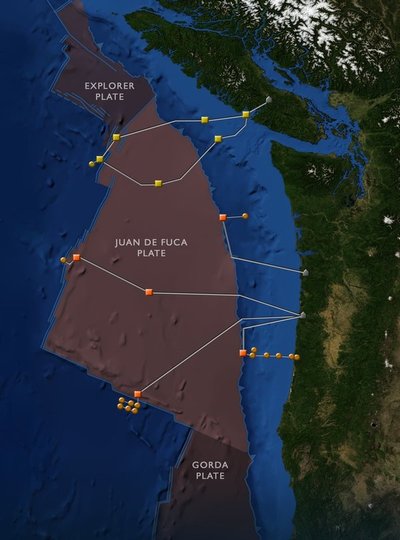August 23, 2007
Coastal/global awards dovetail with proposed $130 million ocean observatory
This morning’s announcement by the Joint Oceanographic Institutions concerning a $97.7 million award to a consortium of Woods Hole Oceanographic Institution, Oregon State University and Scripps Institution of Oceanography for programs to learn more about coastal waters and the world’s oceans follows just months after the University of Washington was selected to develop detailed engineering specifications for a cabled underwater research facility to be built off the coast of Washington and Oregon.
The coastal project off the Oregon coast will be married to the regional cabled system — known as the regional scale nodes project. Moorings and instruments monitoring coastal waters will plug into the cable system for power and communications.
“Completion of the Ocean Observatories Initiative team with WHOI, SIO and OSU is a significant milestone in our progress toward implementing next-generation research strategies we have been planning for more than a decade. A host of crucial societal and basic science issues require this historic transformation to remote, interactive exploration of the ocean with highly capable robots and hundreds of adaptable sensor platforms,” said UW oceanographer John Delaney, lead for the regional scale nodes project.
Regional scale nodes project
- The Joint Oceanographic Institutions announced in May 2007 that the UW had been selected to develop the regional scale nodes component of the National Science Foundation’s Ocean Observatories Initiative. This underwater research facility – a large, cabled array – will be the world’s first robot-sensor network to span a tectonic plate. In the first year of work, the UW will focus on detailed engineering specifications to extend high-speed Internet throughout the deep oceans. The facility will be an essential component in future research and educational strategies of many academic institutions across the country and the world.
- The regional scale node project will enable new approaches to the studies of ocean and Earth processes that, for example, regulate global climate, store human-caused carbon, support major fish stocks and threaten coastlines with storms, tsunamis and harmful algal blooms.
- The planned 750 miles of cable will have five nodes, which are like electrical outlets and Internet connections on the seafloor. Instruments and robots will plug into secondary nodes to draw power, transmit data to shore and receive instructions from operators on land.
- At the time of the announcement in May, the Seattle Times quoted Joint Oceanographic Institution’s Steve Bohlen saying, ” This is the beginning of a new revolution. It’s new science, it’s big science and it’s big risk. But that’s how we make big scientific advances.” Bohlen told the Times that the UW is in line to receive $170 million in National Science Foundation funding including a $130 million construction phase that will start next year. Planning, maintenance and operating costs will account for the rest.
Among steps taken since May announcement:
- Submarine cable systems and network experts hired – Experts from the telecommunications cable industry have been hired to help lead the regional scale nodes program at the UW.
- New cable configuration – UW engineers and scientists have recommended a new cable configuration that radiates across the Juan de Fuca Plate, instead of encircling it.
- Shore sites being considered – Three possible sites are being considered for cable landings and shore stations on the Oregon Coast: Warrenton, Pacific City and Nedonna Beach.
###
For more information:
Delaney, (206) 619-6472, jdelaney@u.washington.edu



